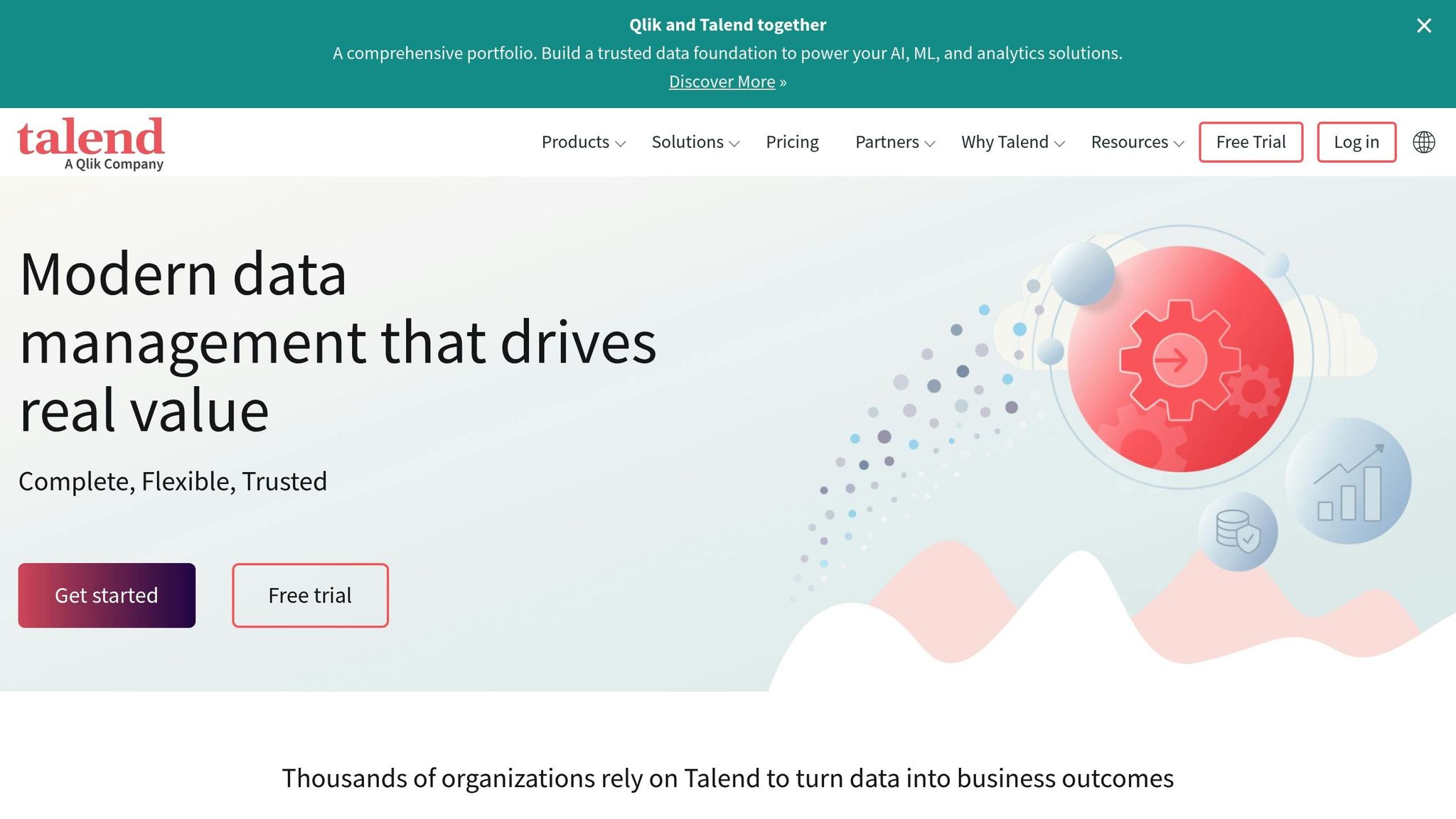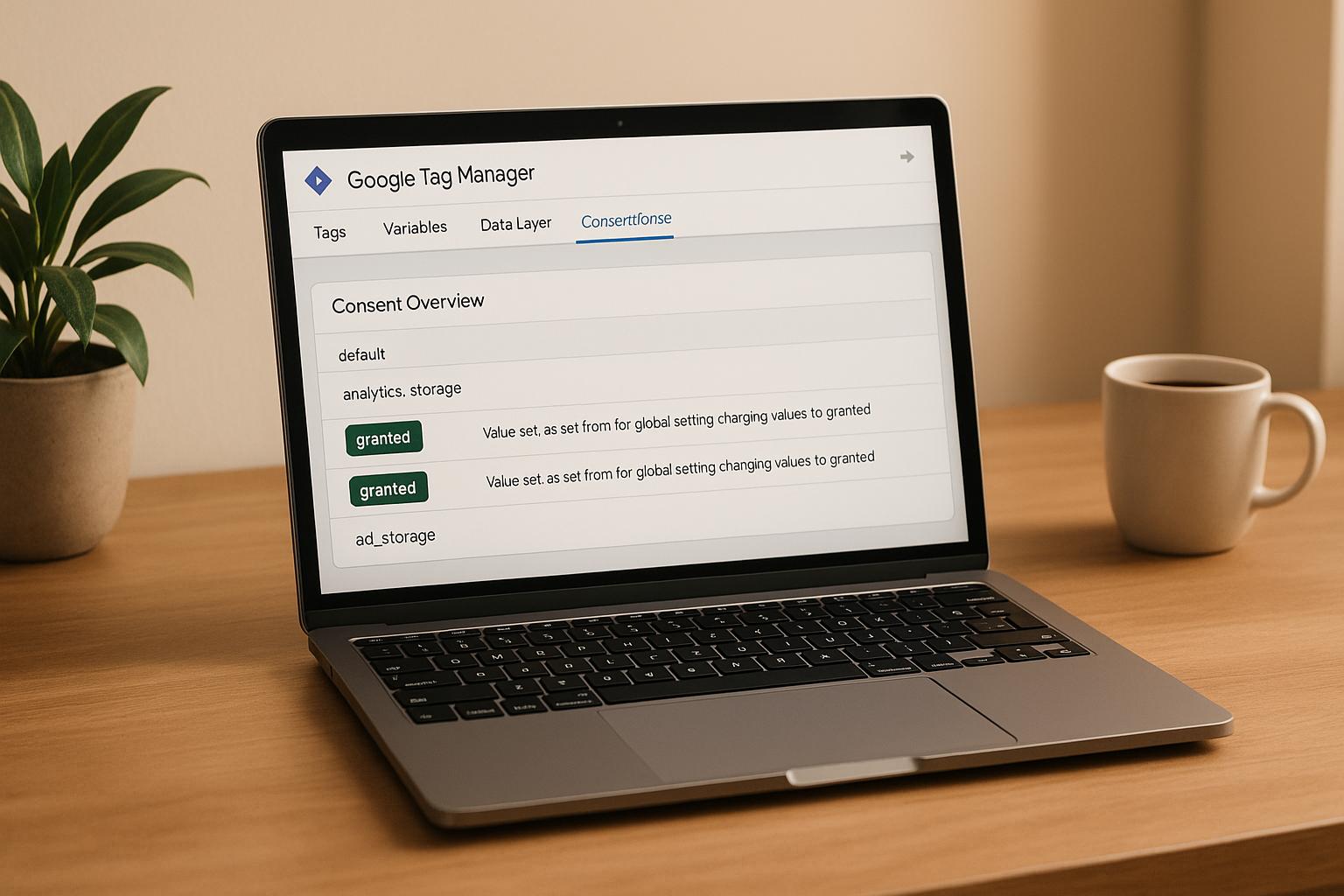Master Data Management (MDM) ensures your business data is accurate, consistent, and accessible across systems. Poor data management can cost businesses billions annually, but the right tools can solve this by integrating, governing, and automating data processes.
Here's a quick breakdown of five leading MDM tools and their strengths:
- IBM InfoSphere: Best for large enterprises needing advanced integration, but has a steep learning curve.
- Informatica IDMC: Excels in AI-powered data quality but can be pricey.
- SAP MDG: Ideal for SAP users, though it lacks hierarchy management.
- Profisee: A cost-effective option for Microsoft-centric mid-sized businesses.
- Talend MDM: Offers open-source and enterprise options, balancing cost and functionality.
Each tool addresses different needs, from real-time updates to AI-driven automation, helping businesses reduce errors, improve compliance, and make smarter decisions. Choosing the right tool depends on your company's size, systems, and goals.
Top 9️⃣ MDM (Master Data Management) Tools in 2022
How to Choose MDM and Data Quality Tools
Choosing the right Master Data Management (MDM) and data quality tools is no small task, especially when poor data quality costs U.S. businesses an estimated $3.1 trillion each year. To avoid costly mistakes, focus on three essential areas: data integration, governance, and automation. These pillars will guide you in selecting a tool that meets your organization’s needs.
Data Integration and Real-Time Sync
A strong MDM solution should seamlessly integrate data from various sources, whether on-premises, in the cloud, or through APIs. Real-time updates, continuous synchronization, and Change Data Capture (CDC) tracking are key features to look for. Tools that offer automated replication, low latency, and effective conflict resolution can ensure your data remains consistent and up to date.
Additionally, prioritize solutions with robust mapping and transformation capabilities. These features are crucial for cleansing, standardizing, and consolidating data from diverse formats, making it usable across your organization.
Governance, Scalability, and Deployment
Effective governance is critical for maintaining high data standards. Look for tools that enforce data policies, streamline processes, and support compliance through features like data cleansing, enrichment, deduplication, and governance workflows. As your business grows, the tool should scale effortlessly to handle increasing data volumes and integrate new business units without sacrificing performance.
Deployment flexibility is another important consideration. Cloud-native solutions offer agility and ease of access, while on-premises options provide tighter control, especially in regulated industries. Hybrid models can combine the best of both worlds. Start by assessing your business needs, defining success criteria, and ensuring the tool’s technical capabilities align with your goals.
Automation and AI for Data Quality
Automation and AI are game-changers when it comes to managing data quality at scale. With global data volumes projected to hit 181 zettabytes by 2025, manual methods simply can’t keep up. AI-driven tools can automate up to 70% of data monitoring tasks, improve efficiency by 20%, and address quality issues proactively.
These tools offer features like automated cleansing, validation, and real-time anomaly detection. Advanced AI can even analyze historical trends to predict potential quality issues, allowing you to resolve them before they escalate. Considering that poor data quality costs businesses an average of $12.9 million annually, investing in AI-powered solutions can deliver substantial returns.
When evaluating tools, look for capabilities like automated data capture, duplicate record identification, and accuracy validation. With the AI-driven data management market expected to reach $30.5 billion by 2026, ensure the solution you choose integrates seamlessly with your existing systems. Support its adoption with comprehensive employee training and a strong data governance framework to maximize its impact.
Top MDM and Data Quality Tools
The world of master data management (MDM) and data quality tools is packed with options tailored to meet diverse business needs. Below, we dive into five standout solutions that consistently deliver for organizations, each offering distinct features and pricing structures.
IBM InfoSphere Master Data Management

IBM InfoSphere Master Data Management is a highly adaptable enterprise solution designed to integrate seamlessly into various infrastructures. It excels at data integration, quality management, workflow automation, and reporting. By centralizing master data for customers, products, suppliers, and locations, it ensures a unified approach to data management. Pricing starts at $31,000 per month for the Managed Small plan, which supports 5 million records, 35 transactions per second, and 2 TB of storage, with higher tiers available for larger data needs. While its capabilities are impressive, the platform is often criticized for its complex interface and steep learning curve.
Informatica Intelligent Data Management Cloud
Informatica's Intelligent Data Management Cloud (IDMC) combines AI-powered quality features with no-code tools to unify and cleanse data. It boasts an average ROI of 324% and annual benefits of approximately $2.25 million. Real-world success stories include Takeda's migration of 96% of its data to the cloud to accelerate clinical trials and Citizens Bank's creation of a unified customer view for real-time personalization. Another example is RS Group, which used Informatica to unify legacy data, enabling customized experiences and AI-ready insights. While it offers flexible hybrid deployment options, its usage-based pricing can make it over 20% more expensive compared to other platforms.
SAP Master Data Governance (MDG)
SAP Master Data Governance is a go-to choice for organizations heavily invested in the SAP ecosystem, particularly SAP S/4HANA users. It often attracts large enterprises with over 10,000 employees and annual revenues exceeding $1 billion. For instance, the Adani Group used SAP MDG to clean and enrich 1.6 million records, achieving a 15–20% boost in productivity and automating six master data processes. Widely used in industries like Information Technology and Software, major users include Mohawk Industries, Inc. and EPAM Systems Inc. However, SAP MDG's custom pricing can be a barrier for some, as it is generally regarded as an expensive solution.
Profisee

Profisee is known for its cloud-native design, strong golden record management, and smooth integration with Microsoft tools. It provides enterprise-grade MDM at a lower overall cost, making it a popular choice for mid-market organizations. Pricing is available through custom quotes. Its scalable architecture and compatibility with Microsoft systems make it an efficient option for businesses seeking streamlined deployment and management.
Talend MDM

Talend MDM offers both open-source and enterprise solutions, allowing businesses to choose an option that aligns with their budget and technical needs. With a focus on data stewardship and seamless integration, Talend connects diverse data sources effectively while maintaining affordability. A notable example is a U.S.-based oil and gas company with over 800 global centers and annual revenues exceeding $12 billion. By using Verdantis Material Harmonize on Talend, the company classified 150,000 materials, normalized attributes, eliminated duplicates, and implemented real-time governance workflows.
sbb-itb-5174ba0
Tool Comparison
Selecting the right MDM and data quality tool requires aligning platform capabilities with your organization's unique needs. While these five tools share core MDM features, their strengths and ideal use cases differ. Below, we break down how each tool serves various requirements and the trade-offs involved.
IBM InfoSphere stands out for its multi-domain support and flexible deployment options. However, its complex interface and intricate licensing structure make it a better fit for large enterprises with advanced data integration demands. Organizations without dedicated IT teams may find it overwhelming.
Informatica IDMC is strong in managing big data relationships and offers flexible deployment options. On the downside, it has a challenging user interface, limited data governance capabilities, and restricted reference data support.
SAP Master Data Governance (MDG), built on SAP HANA, provides flexible workflows and pre-configured data models, making it ideal for businesses already invested in the SAP ecosystem. However, it has limited hierarchy management, which may be a drawback for some users.
Profisee is tailored for Microsoft-centric environments, offering quick implementation and solid golden record management. It’s particularly appealing to mid-sized organizations but falls short in product information management (PIM) capabilities and lacks support for NoSQL databases.
Talend MDM offers both open-source and enterprise solutions, making it adaptable for different budgets. It emphasizes data stewardship and seamless integration, though its specific benefits and limitations depend on the version selected.
Comparison Table
Here’s a snapshot of each tool’s key strengths, weaknesses, ideal use cases, and starting price:
| Tool | Key Strengths | Main Weaknesses | Best For | Starting Price |
|---|---|---|---|---|
| IBM InfoSphere | Multi-domain support, flexible deployment options, scalable governance | Complex interface, intricate licensing | Large enterprises with dedicated IT teams | $31,000/month (managed) |
| Informatica IDMC | Big data relationship management, varied deployment options | Complex UI, limited data governance, limited reference data | Organizations seeking robust data management | Usage-based pricing (custom quote) |
| SAP MDG | SAP HANA integration, flexible workflows, pre-configured models | Limited hierarchy management | SAP ecosystem users, large enterprises | Custom pricing |
| Profisee | Fast implementation, multi-domain capability, Microsoft integration, robust golden record management | Lacks strong PIM capabilities, lacks NoSQL support | Mid-market Microsoft-centric organizations | Custom quote |
| Talend MDM | Open-source option, focus on data stewardship, cost-effective integration | Varies by version (open-source vs. enterprise) | Budget-conscious organizations, diverse data sources | Open-source available |
These comparisons underscore the importance of evaluating tools based on your organization's integration, governance, and automation needs.
For large enterprises with complex data requirements, IBM InfoSphere or SAP MDG may be the best fit. Meanwhile, mid-sized companies might find a better match with Profisee or Talend MDM, depending on their technical expertise and budget.
"Master data management (MDM) fuels business success with better data." – P. Shravan Kumar
MDM Best Practices for Data Quality
Master Data Management (MDM) thrives on strong governance, automation, and monitoring practices to maintain data quality. These practices ensure that MDM tools - whether IBM, Informatica, SAP, Profisee, or Talend - perform effectively, helping organizations avoid common pitfalls and maintain high standards.
Set Up Data Governance Policies
A solid data governance framework is the cornerstone of any successful MDM initiative. Without clear policies and accountability, even the best tools can fall short of delivering consistent results. Governance ensures data accuracy, consistency, integrity, and security across all master data systems.
To establish strong governance, assign roles like data stewards, data owners, and a cross-functional governance council. These roles enforce policies covering security, privacy, retention, and access. The framework should include standards for data collection, storage, integration, transformation, and archival, as well as guidelines for data entry and validation.
For example, a global retail company implemented governance rules that eliminated 95% of duplicate records, leading to a 20% reduction in shipping errors and a 15% boost in customer satisfaction. Similarly, a healthcare organization used governance and survivorship rules to prioritize accurate data sources, ensuring HIPAA compliance while enhancing patient care.
Once governance is in place, organizations can further improve data quality with automation and AI.
Use Automation and AI
Automation powered by AI can increase data team efficiency by up to 50% while reducing operational costs. By 2026, over 80% of enterprises are expected to rely on AI to transform data management.
AI-driven tools excel in tasks like cleansing, anomaly detection, and standardization across systems. Machine learning can predict data quality issues, providing proactive insights into emerging trends. These tools automate data integration, cutting processing times and improving accuracy. Advanced algorithms continuously identify and resolve quality issues in real time, adapting to new data patterns.
Take Holiday Inn Club Vacations as an example. In March 2023, they consolidated seven separate data systems into one platform, managing over 350,000 member profiles. This not only reduced data-entry errors but also allowed for more personalized customer interactions, building brand loyalty. Around the same time, Discount Tire streamlined 70 million customer records, cutting duplication by 50%.
"People often don't realize how messy their approach to data management has become until they look back on it with the clarity offered by MDM. The amazing successes organizations have had in successfully implementing MDM not only make their data more actionable, but they ultimately bring an effective AI strategy in reach." - Prash Chandramohan
Monitor and Audit Data Quality
Even with automation, continuous monitoring is crucial to catching anomalies that AI might miss. Real-time monitoring helps organizations address issues as they arise, preventing small errors from snowballing into bigger problems. Regular audits and assessments are equally important for maintaining long-term data hygiene.
Set up automated alerts and dashboards to notify data stewards of anomalies. Track quality indicators like accuracy, completeness, conformity, and consistency against predefined thresholds. Schedule periodic audits using techniques like data profiling, sampling, and quality scorecards to uncover hidden issues and identify improvement areas. Based on audit findings, implement structured cleansing processes to resolve inaccuracies, remove duplicates, and standardize formats.
The benefits of systematic monitoring are clear. For instance, in March 2023, Spotify collaborated with Mailchimp to clean a 45-million-subscriber database using real-time verification. Led by Email Marketing Manager Sarah Chen, this effort reduced the email bounce rate from 12.3% to 2.1% within 60 days, boosting deliverability by 34% and generating an additional $2.3 million in revenue.
Focus governance efforts on critical data that impacts multiple business functions. Engage data consumers across the organization to identify quality issues and drive improvements. Share quality goals, policies, and metrics to align everyone around common standards.
Conclusion
Master Data Management (MDM) and data quality tools are no longer optional for organizations aiming to make the most of their data. Ignoring data quality can lead to costly inefficiencies and missed opportunities, making it vital to invest in the right tools and strategies.
When choosing an MDM solution, it’s crucial to align the tool with your organization’s specific data requirements. The tools discussed here offer diverse capabilities, ranging from robust enterprise-level integrations to flexible cloud-based solutions and cost-effective open-source options. Each of these aligns with the selection criteria we’ve outlined, helping you identify the best fit for your needs.
Our analysis highlights the importance of focusing on scalability, automation, and governance. By doing so, organizations can achieve significant financial benefits, such as reducing costs by up to 40% within 12–18 months and gaining a sixfold return on investment for every dollar spent. These practices ensure that your MDM efforts turn raw data into a valuable strategic resource.
Consider your deployment options carefully - whether cloud-based, on-premises, or hybrid - while factoring in your regulatory and operational requirements. Additionally, weigh the benefits of open-source tools with strong technical support against comprehensive commercial solutions to determine which aligns better with your organization’s capabilities.
Incorporating data quality measures from the start is key. By pairing proactive quality strategies with continuous monitoring and automation, you can shift data from being a potential risk to a powerful asset that drives informed decision-making.
Don’t leave data quality to chance. Start today to ensure your organization is equipped to make smarter, data-driven decisions tomorrow.
FAQs
What should businesses consider when deciding between cloud-based, on-premises, and hybrid MDM solutions?
When choosing a Master Data Management (MDM) solution, it’s important to weigh several critical factors, including data security, compliance requirements, scalability, cost, and the resources you have on hand.
- Cloud-based solutions are a popular choice for their flexibility, quicker deployment times, and cost savings. They’re particularly well-suited for businesses focused on scaling operations while keeping IT demands low.
- On-premises solutions give you full control over your data, making them a strong option for organizations with stringent security or regulatory requirements.
- Hybrid solutions aim to deliver the best of both worlds, striking a balance between control and adaptability.
To find the right fit, take a close look at your organization’s current needs, future objectives, and the resources available to support your MDM approach.
How do AI and automation improve data quality and cut costs in master data management (MDM)?
AI plays a key role in improving data quality within Master Data Management (MDM). It can spot and fix errors, inconsistencies, and anomalies as they happen, ensuring data remains accurate and dependable. On top of that, AI powers predictive analytics, helping to identify and address potential data problems before they even occur.
Automation takes things a step further by handling tasks like data cleansing, classification, and deduplication. This not only reduces manual labor but also boosts efficiency. By automating these workflows, businesses can lower operational costs by as much as 40% while cutting down on the need for hands-on involvement. The result? Faster, more cost-effective data management.
What are the main strengths and weaknesses of top MDM tools like IBM InfoSphere, Informatica IDMC, and SAP MDG?
IBM InfoSphere is a standout choice for its strong data profiling features and ability to provide real-time data views. This makes it particularly appealing to businesses that place a high value on data analysis. On the flip side, it comes with higher ownership costs and doesn't offer much flexibility when dealing with non-SAP data sources.
Informatica IDMC is praised for its scalable, cloud-based deployment and seamless resource integration, making it a solid pick for organizations focused on adaptability and growth. However, it might fall short in governance features, which could be a concern for larger enterprises.
SAP MDG is well-regarded for its integration capabilities, built-in governance, and automated workflows, making it an excellent match for companies already using SAP systems. That said, it can be challenging to implement and often comes with higher costs.
Each tool has its own strengths: IBM excels in data profiling, Informatica leads in scalability, and SAP stands out in governance and integration.


